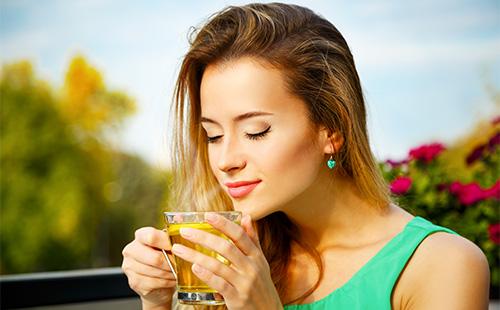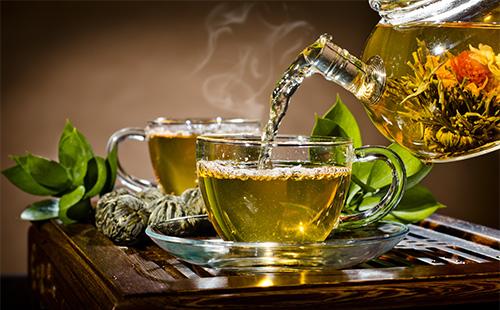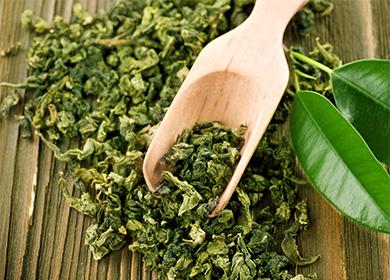The content of the article
Green tea can be attributed to the most ancient drinks. Not everyone knows that any tea (black, green, yellow or white) is obtained from the same tea shrubs. Vary the way the leaves are processed. Depending on the parts of the tea bush that are used as raw materials, the popular golden-clear drink is divided into different varieties. So, for some species only buds are suitable, for others - young upper leaves, while others require exclusively ripe greens.
Production Features
Green tea among its brethren in tea plantations is processed more carefully: it is not subjected to complete fermentation and withering, which is a mandatory process in the production of black tea. In general, processing goes through such stages.
- Fermentation. To preserve the value of tea, after collection, the main transformation of the leaves is carried out - fermentation, that is, oxidation is stopped. The degree and duration of fermentation depends on the type of tea obtained, its taste and beneficial properties. Also, the raw materials are treated with steam for two to three minutes. During this time, the bright aroma of freshly picked petals is removed, they soften, become malleable. Then the leaves are exposed to air to eliminate moisture.
- Twisting. This processing stage is carried out on special units. The plant harvest is wrinkled for about an hour, and then the process of removing moisture by rolling the leaves and giving them a certain shape continues. As a result, the product takes on our usual look. It is believed that strongly curled leaves give a more saturated tea leaves and better retain their natural properties. Varieties with virtually no curled leaf look like grass and are called "unchi". Tea leaves, twisted across the fibers and similar to flakes or balls, are classified as “pearl” varieties. Twisting along the fibers gives the leaves a spiral or thin strip shape.
- Drying or frying. This is the final stage of processing. Leaves, without stirring, at high temperature, bring to the desired condition, fix the aroma and get a tea of mild flavor, dark green. When drying by roasting, the raw material is constantly mixed, acquires an intense aroma, bright green color and no less vivid taste.
Variety of green varieties
The most popular teas today are:
- Xiu longjing- the best in China;
- Tuo Cha and Gyokuro- one of the most expensive;
- Gunpowder - the most sold grade;
- Sencha, or September- most common in Japan;
- Bantya - the most affordable;
- Matcha - powder, add to desserts;
- Yoon Woo - specific, stored in the refrigerator and brewed for only three seconds);
- Mao Feng- has one of the most delicate, fruity tastes.
Depending on the size of the tea petals, green tea can be:
- large-leaved - it is characterized by excellent quality and appropriate value;
- small-leaved - it is more affordable, strong, but not so fragrant;
- powder - This is a gourmet tea that is drunk with tea leaves (the powder filled with hot water is whipped to a foamy state)
- tiled- This is tea that is sold in pressed form, in briquettes of various shapes.
Tiled teas include the Shen Puer variety, whose taste characteristics only become richer and thinner with age. Demonstrates the best taste after a couple of decades of storage.
Useful composition
The benefits of green tea are due to the presence of many chemicals and compounds. According to scientific data, the basic composition of tea includes about five hundred trace elements and more than 400 types of organic compounds. He is a vitamin champion, as it includes almost all vitamins. So which ingredients make green tea so popular?
- Tannins. This is one of the main components of green tea, their content is 15-30%. They represent a complex combination of more than 30 polyphenolic compounds, consisting of powerful antioxidants - tannin, catechins, polyphenols. Their main merit is to give the drink a peculiar taste for which it is loved. They are credited with the ability to strengthen the cardiovascular system, reduce cancer risks and help in losing weight. Green tea is the undisputed leader with a concentration of catechins of 27%. And thanks to tannin, tea is the main source of vitamin R.
- Alkaloids. The most famous is caffeine, which in tea is called thein. It acts gently, stimulates mental and physical activity, is responsible for performance. Green tea of various brands contains from 40 to 85 mg of caffeine in one cup.
- Vitamins Tea is a repository of vitamins of group B. There are vitamins A, E, K, C. in healing tea leaves. Vitamin P is ten times more here than in black tea, and four times more than in citrus.
- Minerals. It contains from four to seven percent of micro- and macrocells required for the "uninterrupted" work of all human organs. The chemical composition of tea is zinc, manganese, magnesium, copper, calcium, potassium, iodine, fluorine, phosphorus and other minerals.
- Amino acids. Tea consists of 17 amino acids. Glutamine is recognized as the most useful. It has a beneficial effect on a weakened nervous system, normalizes metabolism.
- Pectins. They serve as a kind of protective shell on the gastric mucosa, which makes it harder to burn with hot tea than just boiled water.
- Essential oils. A small amount of essential substances (0.02%) does not reduce their important role. Their merit is the unique aroma of tea and the true pleasure of drinking tea.
Valuable properties
The properties of green tea were scientifically studied at the beginning of the 20th century. And although this drink has not been thoroughly studied so far, many of its unique characteristics have been substantiated and proven. In addition to the fact that green tea provides a positive attitude and makes you feel good, it has the following qualities.
- Power Engineer. Doctors have proven the close relationship between mental functions and the use of green tea. The product has beneficial effects on the vessels of the brain, improves blood circulation, and gently affects the nervous system. Thein stimulates mental activity, causes energy and vigor.
- "The doctor." It has a wide range of beneficial effects: it dilutes blood, regulates blood sugar, increases the elasticity of blood vessels, lowers cholesterol, reduces the risk of heart attack and stroke, and eliminates edema. Normalizes digestion. It is the prevention of urinary and cholelithiasis.It takes care of the health of teeth and gums. Heals burns and wounds.
- "Potogon". It has an effective diaphoretic effect. It is recommended for colds, fever.
- Natural biostimulant. It shows biological activity and a stimulating effect on metabolism.
- Immunostimulant. Systemic consumption of green tea enhances immunity, prevents diseases, blocks the development of bacteria.
- Oncoprotector. In Japan, green tea is a must in anti-cancer diets. And although its anti-cancer effect has not been studied, it is used as an oncology prophylaxis. Scientists connect this property of tea with its blood-purifying features (removes carcinogens).
- The orderly. Green tea frees the body from toxins, toxic metal salts (including the radioactive element - strontium-90).
- Antibiotic. The drink has a strong antibacterial, antimicrobial, antiviral effect. Useful in the initial stages of acute respiratory viral infections, with herpes, candidiasis, bacterial infections of the gastrointestinal tract.
- Eco product. Regular consumption of green tea in a certain proportion can neutralize the negative impact of ecology and modern living conditions, reduce the impact on the body of factors such as increased levels of radiation, industrial atmospheric emissions, the effects of mobile communications, computer and television radiation.
- "Esthete". Cosmetology is another area of application of a universal drink, an elixir of beauty and youth. It improves the complexion, fights against acne, refreshes aging skin, keeps it healthy and young and, in principle, slows down the aging of the body (including visual aesthetic). Being a diuretic, it removes excess fluid from the body, which is a prophylactic for cellulite. And rinsing with infusion will return to a greasy, glossy hair a neat, healthy look.
- A drink of longevity. For most centenarians, green tea is the number one drink. The natural components of the tea leaf have a complex effect on all body systems.
"Fly in the ointment": contraindications and the harm of green tea
With all the abundance of positive properties, this miraculous drink has its weaknesses. The following contraindications of green tea are distinguished and cases when it is necessary to limit its use:
- with increased intracranial as well as intraocular pressure;
- with diseases of the genitourinary system;
- in case of exacerbation of joint disease, especially in the elderly;
- in case of chronic diseases of the gastrointestinal tract (in a strongly boiled form it increases acidity, causes heartburn, nausea, diarrhea);
- with tachycardia, atherosclerosis, anemia.
Not useful for people with increased nervous irritability and insomnia (strengthens the heartbeat, provokes trembling in the hands). Excess drink with hypotension can lower the pressure up to fainting. With hypertension, tea abuse is fraught with an increase in blood pressure. Women need to exclude or limit as much as possible green tea during menstruation, since it can cause hormonal disruptions during this period.
Requires a careful approach during pregnancy. During the period of bearing a child, it can increase pressure and pulse rate, increase muscle tone, which is extremely undesirable in this condition. It should not be taken on the eve of childbirth.
The following fact is not widely known, but it has been proven that green tea is able to provoke the formation of kidney stones, as well as the bladder.
In general, it is worth listening to the reviews of doctors who advise everyone to know the measure. A common contraindication for everyone is abuse of a tea drink.
How to avoid side effects
In order not to encounter such side effects of green tea as gastrointestinal upsets, headache, swelling, muscle tremors, palpitations, irritability or, conversely, depression and fatigue, follow these tips.
- When to drink. The habit of almost the majority of tea lovers is to drink it as a continuation of the meal. This is a mistake: absolutely no benefit to you "shines". Drink tea half an hour before meals or an hour and a half after eating. If you do not want to wake up in the morning with “bags” under your eyes, do not drink tea at night (take it at least two hours before bedtime). Do not take green tea on an empty stomach. Drunk on an empty stomach, it irritates its mucous membrane.
- Temperature. Warm tea is best absorbed, but not hot or cold.
- Combination with alcohol and pills. The harm of green tea extends to its combined use with alcoholic beverages: never combine it with alcohol. This can lead to serious malfunctioning of the kidneys. Do not drink medicines with tea.
Get quality loose, not packaged tea. Introduce new varieties into your diet gradually.

Brewing rules
Compared to black tea, the process of brewing green is more specific. The beneficial properties of the tea drink will be preserved only if it is brewed correctly. There are two main secrets.
- Water quality. So that the tea does not lose its aroma, taste, color, and, most importantly, its benefits, you need to fill it only with filtered water, spring or store bottled.
- Water temperature. Properly brew green tea with water whose temperature does not exceed 80-90 ° C. The use of boiling water is unacceptable: it destroys most of the nutrients.
Brewing takes place in four stages.
- Warming up the kettle. Before brewing, it is necessary to warm the “teapot” with boiling water or hot steam.
- Water preparation. Boil water. After opening the lid of the kettle, cool slightly (three to five minutes).
- Brewing. Pour tea leaves at the rate of a teaspoon into a glass of water.
- Infusion. The traditional infusion time is from two to five minutes. Watch the leaves: they should sink to the bottom, and the drink should acquire a golden pistachio hue.
Another way is to open the entire tea bouquet by phased brewing. Tea leaves are poured into a warm kettle at the rate of half a teaspoon per cup.
Pour water at 70-80 ° C in four stages:
- at first - 1/3 of the volume of the teapot;
- in two minutes - up to half;
- two minutes later - 3/4 "teapot";
- in five minutes - half of the water is poured, and its place is filled with boiling water.
The tea leaves can be reused two to three times, but no more.
Green tea with milk
The habit of many is to drink green tea with milk. There are many conflicting opinions about this method. In particular, it is believed that in this combination beneficial properties are neutralized and the taste of both drinks is distorted. They do not agree with this in Tibet: they have been drinking tea with milk for centuries.
Many are sure that “milk milk” quenches rather than thirst, but hunger, and therefore does not have additional useful bonuses, unless an increase in the calorie content of the drink. But those who are mistaken are those who pour milk into tea. According to the rules, on the contrary: tea must be added to milk. Traditionally, two parts of brewed tea go to one part of milk. For taste, just before taking, you can add honey. Drinking a milk-tea drink with diuretic properties is recommended until 16: 00-18: 00.
Tea with milk is relevant for kidney diseases, with a depleted central nervous system, polyneuritis, post-stress conditions. In folk medicine, a drink recipe (a couple of teaspoons per 0.2 l of water) with baked milk (0.2 l) and butter (10 g) is very popular.Drink salt to taste and take two tablespoons several times a day after meals.

Weight Correction Efficiency
A fairly substantial amount of drinks claims to be the leader in losing weight. Chinese statistics say that people who regularly consume green tea have a lower body mass index. Large jumps in blood glucose slow down the process of losing weight. Scientists have found that green tea is an effective stimulant of the pancreas, as a result, blood sugar levels are reduced and stabilized, fat deposits are reduced. Polyphenols in tea improve metabolism and trigger the process of active fat burning. With green tea you can control your appetite: a cup of this golden drink, drunk shortly before meals, will allow you to get enough of a smaller portion of food. The calorie content of green leaf tea without additives is only 2-3 kcal per cup. In short, low-calorie green tea for weight loss and weight loss is a great helper.
If you decide to part with 2-3 kg of your weight, get ready to drink tea several times a day (at least four, but not more than eight cups). Forget about sugar, honey and sweeteners. They will help diversify the taste of a slice of lemon or orange, dried fruits (no more than two), a twig lemon balm or one or two leaves of fresh mint. Reviews of those who lose weight about green tea contain recommendations on adding herbal ingredients to promote weight loss in the drink.
- Hibiscus (or hibiscus). It has a mild laxative and diuretic effect.
- Fruit hawthorn. A characteristic feature of a plant is its ability to lower bad cholesterol and break down fats.
- Powder cinnamon. In a “duet” with green tea, it not only significantly enhances metabolism, but also gives the drink an exquisite taste.
- Ginger. It has the maximum fat-burning effect, normalizes appetite, accelerates metabolism.
- Jasmine. Jasmine green tea is a great mix for dieters. Favorably affects metabolic processes, slows down fat formation.
- Ginseng. Lowers cholesterol, improves metabolism. You can not drink more than three weeks. Ginseng is prohibited if you are taking blood thinners or pills to support your heart. It is also contraindicated in women after 50 years, since it dramatically increases estrogen levels, which can provoke the appearance of tumors.
- Flax seed. A teaspoon of seeds, washed down with a glass of green tea, can suppress even “brutal” appetite.
If you decide on fasting days with tea, consult a gastroenterologist first. Remember that drastic measures (refusal of food in favor of a large amount of green tea) will lead you to a hospital bed. It makes more sense to replace them with black tea, coffee or sweet compote.
Green tea in its valuable qualities is very good and may well become an important part of your weight loss program. Its taste is unique and bright, and the beneficial properties of green tea are difficult to dispute. It remains only to figure out what kind of action this drink has: calming or super-invigorating? In fact, green tea combined both characteristics, it is only important to know how to brew it competently.Take note that tea that is brewed for a couple of minutes will have a tonic effect. In five minutes of brewing, your tea will acquire soothing features. More than six minutes - and the useful essential oils in the cup, as never happened, they disappear. Drink tea preferably 15 minutes after brewing. And insisting it all day, constantly adding boiling water, you voluntarily take "poison".

